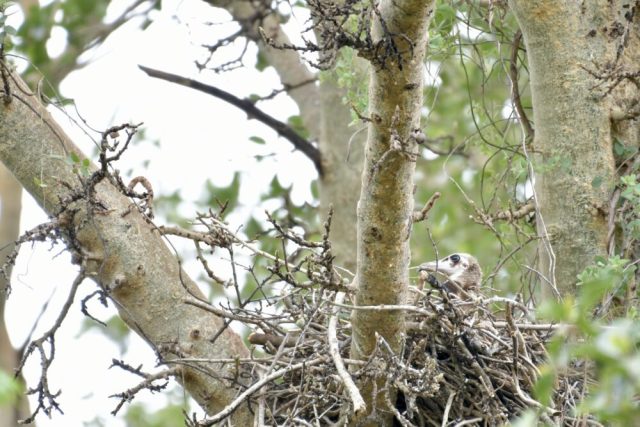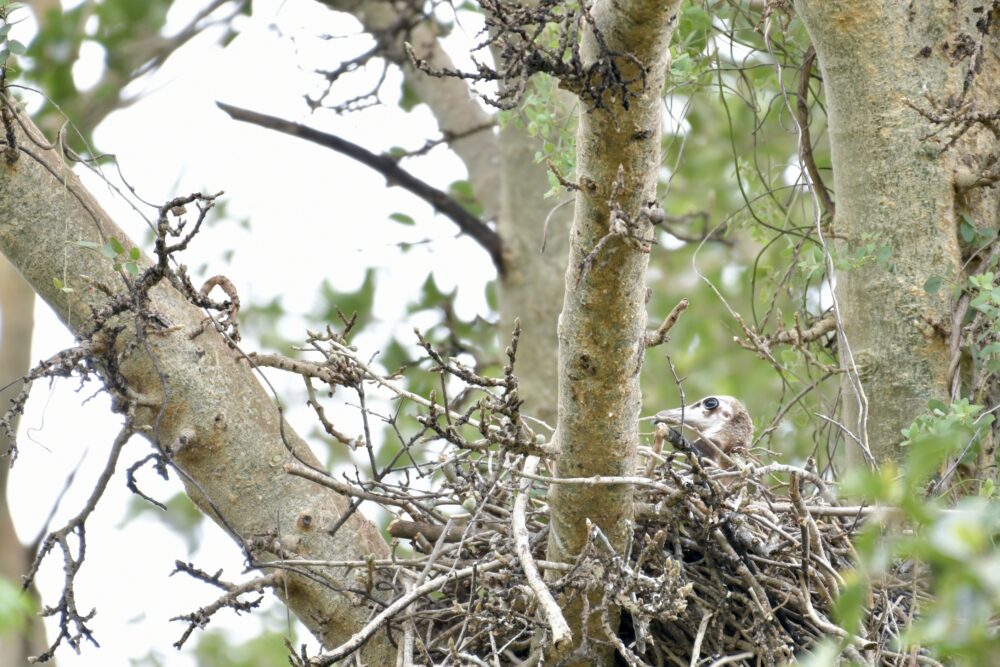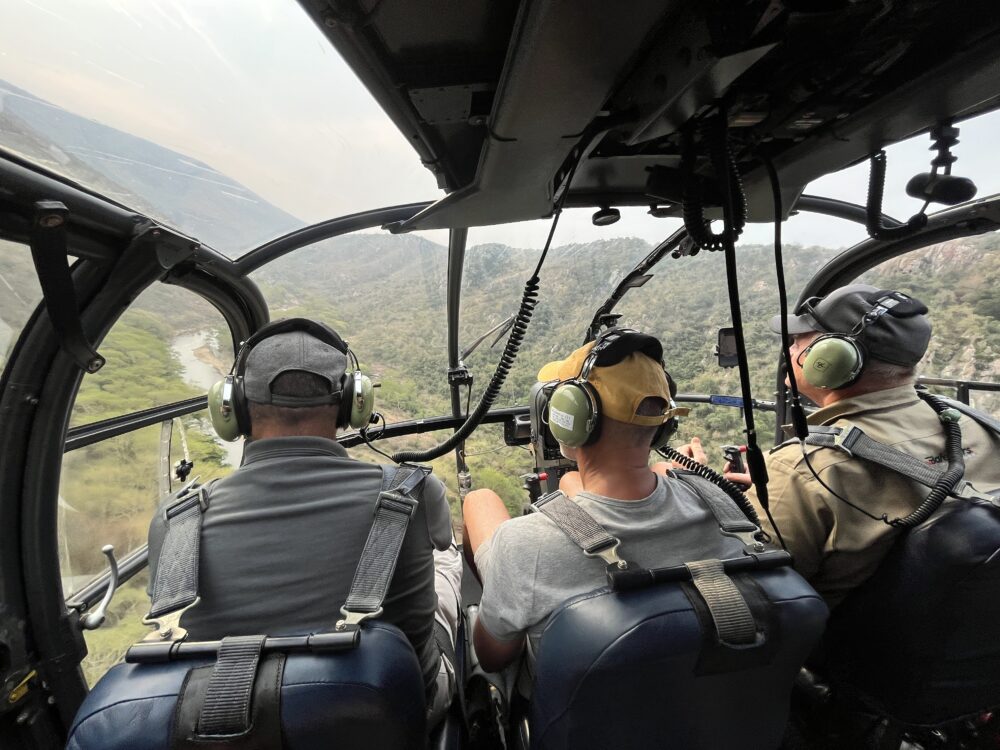
The discovery of KwaZulu-Natal’s first active hooded vulture nest has been hailed as a landmark vulture conservation milestone, with experts calling it a breakthrough for efforts to save one of South Africa’s most threatened bird species.
Found during the 2025 Zululand Vulture Project Aerial Survey, the nest represents the southern-most confirmed breeding site for the critically endangered hooded vulture. The discovery expands the known breeding range of the species and provides vital data to guide future conservation strategies.
“We all feel quite inspired and we’ve got some new hope here,” said Anel Olivier, the species conservation director at the non-profit Wildlife ACT. “It’s nice to see our efforts actually accumulating into something.”
Wildlife ACT, in collaboration with Ezemvelo KZN Wildlife, The Bateleurs and pilot Martin Schulze, recently conducted a helicopter-based vulture survey across key areas of Zululand. This forms part of a five-year monitoring cycle, designed to complement Ezemvelo’s fixed-wing aeroplane surveys and Wildlife ACT’s annual nest monitoring.
Preliminary results revealed a slight increase in lappet-faced vulture nests in Hluhluwe-iMfolozi Park and growth in some African white-backed vulture colonies. Unfortunately, no white-headed vulture nests were found, a pattern which was first confirmed in 2018 and “unfortunately consistently observed since”.
However, it is the the discovery of a single active hooded vulture nest with a large chick that stood out as a moment of historic importance. Considerable effort has gone into locating active vulture nests across KwaZulu-Natal in the past, making this confirmation all the more significant.
“We’ve just never actually recorded an active nest in the province,” Olivier explained. “We’ve seen the adults around and we’ve always thought they have to be nesting somewhere but it’s just been incredibly hard to actually locate their nests because they have their nests just under the canopy of the tree. It’s not as easy as most other vultures that nest right on top of the tree.”
Vultures are among the most threatened bird species in South Africa and KwaZulu-Natal remains a critical region for their survival, noted Brent Coverdale, an animal scientist: mammals and birds at Ezemvelo KZN Wildlife.
The results of this survey highlight both the challenges and the opportunities that conservationists face, he said. “The loss of white-headed vultures is a sobering reminder of what can happen if threats go unchecked, while the confirmation of a hooded vulture nest offers hope and renewed urgency for protecting these birds and the ecosystems they support.”

Fragile population
Only an estimated 50 to 100 breeding pairs of hooded vultures remain in South Africa. Smaller and shyer than other vulture species, the bird weighs between 1.5kg and 2.6kg and has a wingspan of about 1.6m. Its featherless pink face and dark hood allow it to feed efficiently at carcasses, often on scraps left behind by larger vultures.
The species is monogamous, laying one egg per season, with chicks dependent for about
seven months. Very little is known about its breeding behaviour, which makes this confirmed nest more significant for research and conservation planning.
This discovery “shows that even when populations are under immense pressure, with the right monitoring and protection, these species can still surprise us,” said the Zululand Vulture Project, a joint initiative led by Ezemvelo KZN Wildlife and Wildlife ACT.
“Confirming a hooded vulture nest for the first time in the province gives us new insight into their range and behaviour and strengthens the case for continued collaboration and investment in vulture conservation.”

Targeted poisoning
Northern KwaZulu-Natal is a stronghold for vulture conservation yet it is also one of the regions most severely affected by targeted poisoning, Olivier said.
Tree-nesting vulture breeding clusters in some key areas across Zululand have been wiped out within just a few years, while white-headed vultures are now considered extinct as a breeding species in the province.
Poisonings, whether deliberate or accidental, are the leading cause of vulture deaths in South Africa, she said. “Deliberate poisonings in KwaZulu-Natal are often linked to the illegal trade for traditional medicine or predator control, while accidental poisonings result from lead ammunition fragments or veterinary drugs.”
Vultures play an irreplaceable ecological role. As obligate scavengers, they remove carcasses rapidly and prevent the spread of diseases such as anthrax, rabies and botulism.
“The ecosystem services vultures provide carry immense economic and ecological value, although their true worth is often underestimated. Without them, carcasses decompose more slowly and disease risks for wildlife, livestock and people increase.”
Collaboration is key
The confirmed hooded vulture nest highlights the importance of long-term monitoring,
collaboration and community involvement in protecting South Africa’s most threatened birds.
Safeguarding vultures requires strong collaboration, the conservationists said. Conservation authorities, NGOs, researchers, landowners and communities all play a vital role in monitoring populations, responding to poisoning incidents and securing safe feeding sites.
The role of private landowners is critical. Many vulture nests in KwaZulu-Natal fall outside formally protected areas, which means their survival depends on the willingness of landowners and farmers to safeguard breeding sites and allow conservation teams access for monitoring.
By protecting habitat, reporting suspicious activity and supporting safe food sources, private landowners play a direct role in keeping populations stable.
“This hooded vulture nest that we found is actually on private property on a farm … It’s not got this sort of immediate protection status,” Olivier said. “It’s now a matter of engaging further with the property owners and managers to make sure that they continue to protect this area and that the area remains undisturbed.
“There’s lots of avenues we can take, legally or not, and it’s all about relationship-building, which is probably the biggest element of vulture conservation across the world.
The data from this survey will guide conservation strategies in the months ahead.
“We will continue to try to find more nests; we are quite sure there has to be more. We’ve spent quite a bit of time looking for more but, unfortunately, no success so far.
“At the end of the breeding season, the chick we saw two weeks ago was pretty big already and flying off, so I think our chances of finding more nests this season is quite low but we’ll try again next year.”
The discovery, she said, would potentially enable more funding opportunities and has certainly raised more questions on whether the species’s breeding range is expanding.
“And do we need to do research into why it is expanding. Is it climate change or has it always been there? Obviously we’ll never find that out, but the more we monitor, the more we know and the more we can do about it,” she said.
The 2025 survey was coordinated by Chris Kelly and Anel Swart of Wildlife ACT and Brent Coverdale of Ezemvelo KZN Wildlife, with vital support from The Bateleurs, Shiptech, Ford Wildlife Foundation, Dry Creek Foundation, Briandez Legacy Trust and Happy Hollow Foundation.
Steve McCurrach, the director of The Bateleurs, said it was always ready to provide the, often vital, aerial support to any legitimate conservation and environmental care programmes.
“Being part of the team that confirmed this hooded vulture nest was a powerful reminder of why these efforts matter.”
Discovery of a hooded vulture nest offers hope and renewed urgency for protecting these critically endangered birds



